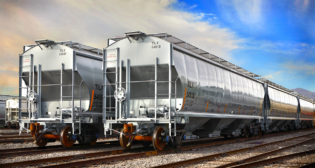
Freight car backlog nears 125,000
Written by William C. Vantuono, Editor-in-Chief“The railcar market continues to surge,” said EPA principal Peter Toja. “Even though assemblies accelerated in the third quarter, incoming orders of 42,900 cars and platforms far outpaced deliveries of 18,432 units. Most noteworthy of the third-quarter expansion in orders was the widespread demand for a number of car types. Strong increases were recorded by all types of covered hoppers, intermodal equipment, Class F cars, and tank cars. Even the long neglected boxcar segment expanded at a vigorous pace in the third quarter.”
Based on the ongoing strength in several railcar types, EPA has raised its short- and long-term deliveries forecasts. Toja says he now expects deliveries of 68,500 cars and platforms this year, followed by assemblies of 84,500 units in 2015. Longer term, he expects deliveries to moderate at significantly higher levels than EPA’s most recent forecast. After 76,800 cars are delivered in 2016, deliveries will remain at “the healthy level of some 75,000 cars through 2019.”
“In spite of a sluggish economy, the major railroads recorded strong financial performances in third quarter, and were indicating strong investments in a number of areas, primarily for intermodal equipment and terminal facilities” Said Toja. “In addition to new intermodal terminals, expansion and modernization of existing facilities were cited by the railroads. And, we believe that these investments will be well founded as the roads look to increase market share at the expense of the long haul truckers.
“On a very positive note, demand for boxcars jumped in the third quarter. According to industry sources, the 3,510 cars ordered in the third quarter were primarily for equipment destined for TTX. It now appears that after years of neglect, TTX is looking to upgrade its extremely aged general service cars.
“Aside from TTX, there seems to be little support for boxcars from individual investors or users of boxcars. As we mentioned in previous reports, we continue to believe that the steady expansion in motor vehicle demand and production is leading to a revitalization of auto parts boxcars. However, non-automotive demand seemed quite subdued until the TTX order was placed with two builders.
“Demand for hi-cube covered hoppers turned in another impressive gain in the third quarter. Orders for 2,875 cars nearly matched the 2,950 cars ordered in the second quarter. As a result, even with a significant increase in third-quarter assemblies, backlogs expanded once again to 9,764 cars at the end of September.
“Responding to an apparent shortage of grain service cars, demand for mid-sized covered hoppers rose to an impressive 4,230 cars in the third quarter. With only a moderate pickup in third-quarter assemblies, backlogs at the end of September were 9,578 units, ensuring that carbuilders would have hefty backlogs as 2015 unfolds. And the outlook for grain will also support further gains in demand for grain service cars.
“Orders for small-cube covered hoppers jumped to 16,597 cars in the third quarter. And, with orders through September far outpacing production runs, backlogs have expanded from 3,228 units at the beginning of the year to a very formidable level of 34,334 cars at the end of September.
“Based on assemblies to date and existing backlogs, we expect small-cube covered hoppers deliveries of 13,000 this year and 16,000 in 2015.
“Demand for coal carrying equipment expanded moderately in the third quarter. After only 154 cars were ordered in the second quarter, third quarter orders amounted to 705 units. Still, the increase in third-quarter assemblies moderately eased backlogs from 2,140 cars at midyear to 2,092 units at the end of September. While electric utility coal consumption improved in this year’s first half, we expect limited demand for coal equipment until the export markets rebound in the years to come.
“In spite of further idling of coal-fired capacity by the utilities and continued pressure by the Obama Administration and the Environmental Protection Agency, domestic coal consumption advanced 3.4% year over year in the first half of 2014. In the export markets, foreign demand for U.S. coal has weakened. Through July of this year, our exports were running 15.5% below the comparable period of last year. However, we continue to believe that over the longer term, our coal exports will expand significantly. And, both Arch Coal and Peabody Energy also anticipate strong growth in coal demand overseas.
“Demand for intermodal equipment is gaining momentum. First-quarter orders of 2,207 platforms were exceeded by orders of 3,313 platforms in the second quarter, followed by a further strong increase to 4,696 platforms in the third quarter. As a result, in spite of a pickup in assemblies, backlogs at the end of September were 8,184 units, almost a tenfold expansion over the opening year backlogs of 825 units. And, we expect further gains in demand for intermodal equipment as we proceed through 2014, 2015, and into the longer term.
“Demand for non-intermodal flat cars is expanding rapidly. After 1,050 units were ordered in the second quarter, third-quarter orders amounted to 2,150 cars. As a result, backlogs expanded for the second consecutive quarter and now amount to 3,104 cars, the highest level since the first quarter of 2013.
“As we had anticipated, demand is being driven by autorack carriers. And, given the expansion in North American light production in recent years as well as the anticipation of further growth in NA production, we look for further gains in demand for the autorack carriers.
“Based on assemblies through September and current backlogs, we continue to look for deliveries of 3,000 Class F flats both this year and next.
“After 1,542 cars were ordered in the second quarter, there was no interest in mill gondolas in the third quarter. As a result, the acceleration in assemblies served to draw dawn backlogs from 3,097 at midyear to 2,228 cars at the end of September.
“Demand for tank cars continues to impress. After 10,628 cars were ordered in the second quarter, third-quarter orders amounted to 8,137 cars. As a result, in spite of a significant pickup in assemblies, end-of-September backlogs amounted to a healthy level of 51,582 cars. And, based on the latest projections of oil production and impending legislative issues, we look for further growth in demand for oil service tank cars. The anticipated growth in U.S. oil production, particularly from the Bakken oil shale formation, has been well documented.
“Spurred by the use of hydraulic fracturing or fracking in shale rock deposit, U.S. oil production has jumped from 5.0 million barrels per day in 2008 to 7.4 million last year and is expected to average 8.5 million this year and 9.3 million next year, according to the Energy Information Administration, the analytical arm of the Department of Energy. On the regulatory front, builders are responding to the Notice of Proposed Rule Making (NPRM) on hazardous material tank cars carrying crude oil and ethanol. At issue here is the retrofitting or replacement of a number of DOT-111 tank cars as well as the most recently built CPC-1232 tanks cars with enhancements to the bottom outlet value and pressure relief values that will reduce the likelihood of tank cars releasing contents in derailments. The latest estimates are that 90,000-100,000 cars currently in the fleet will be affected by increased safety regulations.
“Due to the rapid expansion in oil production and the lack of any significant pipeline additions, rail will continue to benefit, and we anticipate strong annual deliveries of oil service tank cars throughout the forecast horizon.



